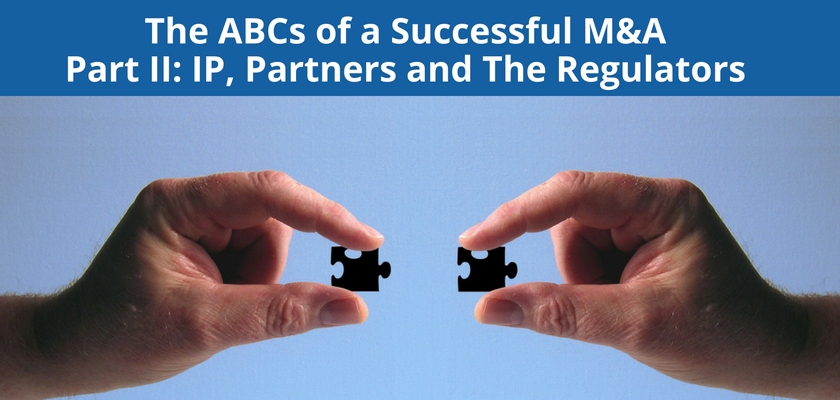Mergers and acquisitions may not have started with Adam and Eve, but they’ve been with us for a very long time, and as with any successful relationship, they require planning, preparation and hard work. In Part I of our look at M&As, we discussed some of the reasons for M&As, the due diligence required, and some of the human resource implications. In addition to cautioning that like Adam and Eve, most M&As — 70-90% — fail. In Part II, we are going to discuss intellectual property, strategic partners and regulatory approvals. In Part III, we’ll conclude with some thoughts on the financial and timing considerations.
Although there are many reasons for an M&A, one of the most common — and complex — is intellectual property. IP is defined as ‘Knowledge, creative ideas, or expressions of human mind that have commercial value and are protectable under copyright, patent, servicemark, trademark, or trade secret laws from imitation, infringement, and dilution, and includes brand names, discoveries, formulas, inventions, knowledge, registered designs, software, and works of artistic, literary, or musical nature.

According to a report from Frost & Sullivan, more than 80% of key growth processes are impacted by IP. The top 10 growth processes are: merger & acquisition; geographic expansion; new product development; competitive strategy; new product launch; strategic partnering; growth sourcing (outsourcing); distribution channel optimization; new customer application; and, marketing/sales strategy.
When IP is a critical component of an M&A, it is essential to understand just what assets are involved, how they are protected and what issues, i.e. infringements, are outstanding and/or pending. This should be part of the due diligence process to help determine what you’re being sold for is what you’re actually buying, i.e. does the seller really own the IP, and what, if any, limitations or restrictions may be attached to that ownership.
IP assets can include patented or patent pending products and services, registered and unregistered trademarks, Internet domain names, trade secrets and proprietary technology and processes. All details — and documents — about these assets, i.e. ownership, jurisdictions and key dates, must be determined and/or confirmed. In addition, don’t forget about key personnel, who have either already left the company to be acquired, or who may not stay.
Doing everything yourself is a recipe for disaster. Partners can bring skills and resources that complement and expand your skills and resources, and a strategic partner can provide even more value, making a company more competitive. According to a recent study, more CEO’s cited strategic partnerships as their number-one growth strategy than any other (ahead of new product launches and geographic expansion).
Like M&A’s, forging successful partnerships is extremely challenging, with up to 70% failure rates. So it should come as no surprise that how you go about identifying and pursuing a strategic partner involves a similar process to an M&A:
- what additional capabilities and resources are required to advance your company to the next level
- how do the prospective candidates match with those required capabilities and/or resources
- how do you contract with the desired candidate and ensure a smooth onboarding process
- what do you need to do to ensure that the relationship continues to meet your changing needs
Then there are the regulators and regulatory approval. Depending upon the size and scope of the M&A, this may or may not be an issue. In the case of the biggest IT M&A, Dell buying EMC, the $60-billion-plus deal is currently on hold, following shareholder and US and EU regulatory approvals, while Chinese antitrust regulators drag the process out.
The US, EU and China are the three biggest geographic/political regulatory powerhouses, but there are other financial (i.e. SEC), industry and political regulatory barriers that may have to be surmounted before an M&A can close. Regulator considerations can include market share issues and implications for competitors.
The odds are against you when it comes to making a successful merger and/or acquisition, but the potential benefits are so compelling, that we continue to see more and more M&As. Looking after intellectual property issues, partnership relationships and regulatory approvals can go a long way to smoothing the process and delivering a positive outcome. In Part III, I’ll provide some thoughts on the financial and timing considerations.


